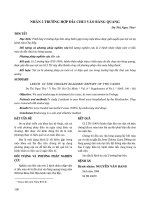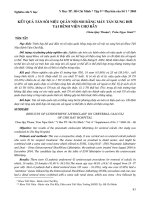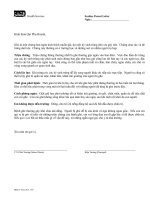Sanitation & Hygiene docx
Bạn đang xem bản rút gọn của tài liệu. Xem và tải ngay bản đầy đủ của tài liệu tại đây (1.99 MB, 49 trang )
Project co-financed by
European Union
Project co- financed
by Asean
European Committee
for Standardization
Implementing Agency
Module 5
GMP Workshop Kuala Lumpur 14 – 16
November 2005
1
Prepared by
Ofelia M. Malagkit - Philippines
Approved by :
ASEAN Cosmetic GMP Team
Endorsed by:
ASEAN Cosmetic Committee
ASEAN GMP TRAINING MODULE
SANITATION & HYGIENE
Project co-financed by
European Union
Project co- financed
by Asean
European Committee
for Standardization
Implementing Agency
Module 5
GMP Workshop
Kuala Lumpur 14 –
16 November 2005
2
CONTENT OF PRESENTATION
1. Basic description
a. Introduction
b. Objectives
c. Scope
d. Basic cleaning principles & practices
2. Personnel hygiene
3. Sanitation of premises
4. Sanitation of equipment
5. Conclusion
6. References
Project co-financed by
European Union
Project co- financed
by Asean
European Committee
for Standardization
Implementing Agency
Module 5
GMP Workshop
Kuala Lumpur 14 –
16 November 2005
3
BASIC DESCRIPTION
Project co-financed by
European Union
Project co- financed
by Asean
European Committee
for Standardization
Implementing Agency
Module 5
GMP Workshop
Kuala Lumpur 14 –
16 November 2005
4
High level of hygiene and sanitation shall be practiced
in every aspect of manufacturing cosmetic products.
The scope of hygiene and sanitation covers personnel,
premises, equipment, apparatus, production materials
and containers, and environment.
Any source of contamination shall be eliminated
through an integrated comprehensive program of
sanitation and hygiene.
In all instances, the hygiene and sanitation procedures
shall be periodically assessed to ensure that the
effectiveness of the operation meets the requirements.
INTRODUCTION
Project co-financed by
European Union
Project co- financed
by Asean
European Committee
for Standardization
Implementing Agency
Module 5
GMP Workshop
Kuala Lumpur 14 –
16 November 2005
5
The aim of sanitation and
hygiene measures is to
eliminate all potential
sources of contamination
and cross-contamination
from all areas where the
product quality is at risk.
OBJECTIVES
Project co-financed by
European Union
Project co- financed
by Asean
European Committee
for Standardization
Implementing Agency
Module 5
GMP Workshop
Kuala Lumpur 14 –
16 November 2005
6
Sanitation and hygiene should be practiced to
avoid contamination of personnel and during
manufacturing of products.
It should cover all aspects of manufacturing:
Personnel
Premises
Equipment and apparatus
Production materials and containers
Products for cleaning and sanitation
All potential sources of contamination
SCOPE
Project co-financed by
European Union
Project co- financed
by Asean
European Committee
for Standardization
Implementing Agency
Module 5
GMP Workshop
Kuala Lumpur 14 –
16 November 2005
7
Cleaning and sanitation is a key consideration when
designing premises and equipments to operate in a
cosmetic industry.
Proper cleaning plays an important role. The methods
used to establish a clean manufacturing environment
vary from company to company. The goal is always the
same, to acquire the level of cleanliness to maintain a
high product quality while minimizing costs.
To understand the concept of cleanliness, it is
necessary to define some common words used in the
industry. Most important are the words
clean
clean
,
sanitation
sanitation
,
hygiene
hygiene
,
and
sterile
sterile
.
CLEANING PRINCIPLES
Project co-financed by
European Union
Project co- financed
by Asean
European Committee
for Standardization
Implementing Agency
Module 5
GMP Workshop
Kuala Lumpur 14 –
16 November 2005
8
Cleaning operations shall be performed in a manner to prevent
contamination of materials and products.
Cleaning practices can be divided by :
“deep cleaning”,
“housekeeping cleaning”, and
“maintenance cleaning”.
All cleaning compounds and sanitizers shall be properly labelled
and stored in a locked compartment, away from production and
storage areas.
Cleaning equipment and tools shall be supplied and be readily
available for use. All cleaning equipments shall be maintained and
stored in such a way as not to contaminate product or equipment.
CLEANING PRINCIPLES
Project co-financed by
European Union
Project co- financed
by Asean
European Committee
for Standardization
Implementing Agency
Module 5
GMP Workshop
Kuala Lumpur 14 –
16 November 2005
9
For personnel :
To prevent contamination risk that effect
personnel health
For product :
To prevent contamination of the products
To maintain the high standard of product quality
For company :
To save on cost, avoid reworks and rejects
To avoid consumer complaints
To avoid potential product recall
For consumers :
To get safe and good quality product
BENEFITS
Project co-financed by
European Union
Project co- financed
by Asean
European Committee
for Standardization
Implementing Agency
Module 5
GMP Workshop Kuala Lumpur 14 – 16
November 2005
10
S
A
N
I
T
A
T
I
O
N
H
Y
G
I
E
N
E
PERSONNEL
HYGIENE
Project co-financed by
European Union
Project co- financed
by Asean
European Committee
for Standardization
Implementing Agency
Module 5
GMP Workshop
Kuala Lumpur 14 –
16 November 2005
11
Personal hygiene will usually be the main
element in the term “hygiene”; the
reason being obvious.
Bacteria causing diseases or spoilage
may be carried and transmitted to
surfaces and product by workers
handling the cosmetic products.
BASIC HYGIENE
Project co-financed by
European Union
Project co- financed
by Asean
European Committee
for Standardization
Implementing Agency
Module 5
GMP Workshop
Kuala Lumpur 14 –
16 November 2005
12
All personnel working in direct contact with products
shall conform to hygienic practices while on duty to the
extent necessary to protect the product against
contamination. The methods for maintaining cleanliness
include, but are not limited to:
1. Wearing outer garments suitable to the operation in a manner
that protects against the contamination.
2. Maintaining adequate personal cleanliness.
3. Washing hands thoroughly (and sanitizing if necessary to
protect against contamination with undesirable microorganisms)
4. Maintaining gloves, if they are used in product handling, in an
intact, clean, and sanitary condition.
5. Wearing, where appropriate, in an effective manner, hair cap,
beard covers, or other effective hair restraints.
GENERAL REQUIREMENTS
Project co-financed by
European Union
Project co- financed
by Asean
European Committee
for Standardization
Implementing Agency
Module 5
GMP Workshop
Kuala Lumpur 14 –
16 November 2005
13
Employees shall be encouraged to
practice good personal hygiene habits
at all times.
Personnel should be healthy and
capable to perform their assigned
duties.
Regular medical examination must be
conducted for all production personnel
involved in manufacturing processes.
during recruitment process
every regular period
√
X
HEALTHY & GOOD HABIT
Project co-financed by
European Union
Project co- financed
by Asean
European Committee
for Standardization
Implementing Agency
Module 5
GMP Workshop
Kuala Lumpur 14 –
16 November 2005
14
Personnel must practice good
personal hygiene.
regular bathing every day
brushing of teeth
washing hands
before entering the
production area
after visiting the toilet
after eating
after smoking
GOOD PERSONNEL HYGIENE
Project co-financed by
European Union
Project co- financed
by Asean
European Committee
for Standardization
Implementing Agency
Module 5
GMP Workshop
Kuala Lumpur 14 –
16 November 2005
15
1.Wet your hand
with flowing
water
2.Use soap
around your
hand and
fingers.
3.If needed use
brush to clean
your nails
4.Rinse your hand
with flowing
water
5.Dry your hand
with tissue or
hand dryer at
32
0
– 60
0
C.
6.Don’t touch
anything. If can
not be avoided,
repeat step 1-5
HAND WASHING GUIDELINES
Project co-financed by
European Union
Project co- financed
by Asean
European Committee
for Standardization
Implementing Agency
Module 5
GMP Workshop
Kuala Lumpur 14 –
16 November 2005
16
All authorized personnel entering
the production areas should practice
good personal hygiene including
wearing of proper attire, suitable
headwear and footwear.
To avoid cross contamination,
personnel should not move between
areas producing different products.
PROPER ATTIRE
Project co-financed by
European Union
Project co- financed
by Asean
European Committee
for Standardization
Implementing Agency
Module 5
GMP Workshop
Kuala Lumpur 14 –
16 November 2005
17
Personnel should wear clean attire
appropriate to the duties they perform.
Design of the attire should not have:
fiber materials
pocket at upper part of the waist.
Personal items such as pens, pencils, or
thermometers shall be carried in pockets
or pouches below the waist when
employees are in production areas.
DESIGN OF ATTIRE
Project co-financed by
European Union
Project co- financed
by Asean
European Committee
for Standardization
Implementing Agency
Module 5
GMP Workshop
Kuala Lumpur 14 –
16 November 2005
18
Wrong
Right
Male Female
PROPER WEARING OF HEAD CAP
Project co-financed by
European Union
Project co- financed
by Asean
European Committee
for Standardization
Implementing Agency
Module 5
GMP Workshop
Kuala Lumpur 14 –
16 November 2005
19
Avoid direct physical contact with
the product to protect from
contamination.
Personnel should wear protective
attire when working with
hazardous materials
Dust mask
smoke mask
gogglesgloves
moustache &
beard cover
SAFETY ATTIRE
Project co-financed by
European Union
Project co- financed
by Asean
European Committee
for Standardization
Implementing Agency
Module 5
GMP Workshop
Kuala Lumpur 14 –
16 November 2005
20
Personnel who have an illness or
open lesions that are likely to
present a risk to the product,
should not be allowed to carry out
operations that involve handling of
starting materials, intermediates
or finished products until the
condition has cleared up.
VISIBLE ILLNESS & OPEN LESIONS
Project co-financed by
European Union
Project co- financed
by Asean
European Committee
for Standardization
Implementing Agency
Module 5
GMP Workshop
Kuala Lumpur 14 –
16 November 2005
21
Personnel should be instructed
and encouraged to report to their
immediate supervisor when they
are ill or when they see any
conditions that may adversely
affect the product quality.
PERSONNEL WITH ILLNESS
Project co-financed by
European Union
Project co- financed
by Asean
European Committee
for Standardization
Implementing Agency
Module 5
GMP Workshop
Kuala Lumpur 14 –
16 November 2005
22
Prohibit use of artificial
eyelash, synthetic nail, and
other beauty accessories that
can fall into the products.
Hair combing is allowed
only in the locker room.
Prohibit use of rings,
earring, and other
jewelries in production
area
REGULATION IN PRODUCTION AREA
Project co-financed by
European Union
Project co- financed
by Asean
European Committee
for Standardization
Implementing Agency
Module 5
GMP Workshop
Kuala Lumpur 14 –
16 November 2005
23
“No Eating”, “No Drinking”, “No Smoking”, and
“No Chewing Gum” policy shall be strictly
implemented as well as no spitting on the floor.
Food shall not be kept in production, warehouse or
laboratory area.
No Smoking
No Eating,
No Drinking
NO EATING, DRINKING & SMOKING
Project co-financed by
European Union
Project co- financed
by Asean
European Committee
for Standardization
Implementing Agency
Module 5
GMP Workshop Kuala Lumpur 14 – 16
November 2005
24
PREMISES SANITATION
Project co-financed by
European Union
Project co- financed
by Asean
European Committee
for Standardization
Implementing Agency
Module 5
GMP Workshop
Kuala Lumpur 14 –
16 November 2005
25
Cleaning and sanitation alone
will not assure a hygienic
standard in production. Process
hygiene as well as personal
hygiene are important factors.
Buildings / facilities should be
so constructed that clean and
unclean processes and products
do not mix.
A well-planned, well-executed and controlled cleaning and sanitation
programme for rooms, machines and equipment is very important to
achieve a hygienic standard.
The cleaning program must be performed regularly, dependent on the
demand for cleaning in the specific areas. The requirements for
cleaning have to be defined before establishing the cleaning program.
GOOD HOUSEKEEPING PRINCIPLES









